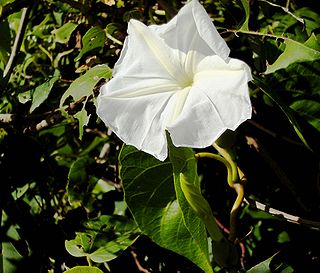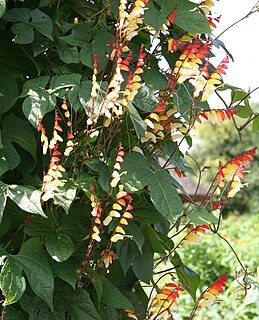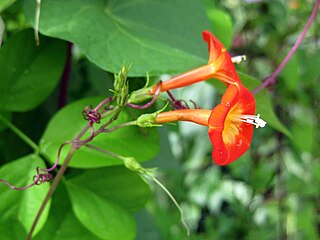
Morning glory is the common name for over 1,000 species of flowering plants in the family Convolvulaceae, whose current taxonomy and systematics are in flux. Morning glory species belong to many genera, some of which are:

Ipomoea is the largest genus in the flowering plant family Convolvulaceae, with over 600 species. It is a large and diverse group, with common names including morning glory, water convolvulus or kangkung, sweet potato, bindweed, moonflower, etc.

Ipomoea aquatica is a semi-aquatic, tropical plant grown as a vegetable for its tender shoots and it is not known as to where it originated. This plant is known in English as water spinach, river spinach, water morning glory, water convolvulus, or by the more ambiguous names Chinese spinach, Chinese watercress, Chinese convolvulus or swamp cabbage, or kangkong in Southeast Asia and ong choy in Cantonese.

Ipomoea alba, sometimes called the tropical white morning-glory or moonflower or moon vine, is a species of night-blooming morning glory, native to tropical and subtropical regions of North and South America, from Argentina to northern Mexico, Florida and Puerto Rico. Though formerly classified as genus Calonyction, species aculeatum, it is now properly assigned to genus Ipomoea, subgenus Quamoclit, section Calonyction.

Ipomoea purpurea, the common morning-glory, tall morning-glory, or purple morning glory, is a species in the genus Ipomoea, native to Mexico and Central America.

Ipomoea quamoclit is a species of vine in the genus Ipomoea native to tropical regions of the New World and naturalized elsewhere in the tropics.

Ipomoea violacea is a perennial species of Ipomoea that occurs throughout the world with the exception of the European continent. It is most commonly called beach moonflower or sea moonflower as the flowers open at night.

Ipomoea pes-caprae, also known as bayhops, bay-hops, beach morning glory or goat's foot, is a common pantropical creeping vine belonging to the family Convolvulaceae. It grows on the upper parts of beaches and endures salted air. It is one of the most common and most widely distributed salt tolerant plants and provides one of the best known examples of oceanic dispersal. Its seeds float and are unaffected by salt water.

Ipomoea cairica is a vining, herbaceous, perennial plant with palmate leaves and large, showy white to lavender flowers. A species of morning glory, it has many common names, including mile-a-minute vine, Messina creeper, Cairo morning glory, coast morning glory and railroad creeper.

Ipomoea lobata, the fire vine, firecracker vine or Spanish flag, is a species of flowering plant in the family Convolvulaceae, native to Mexico and Brazil.

Ipomoea indica is a species of flowering plant in the family Convolvulaceae, known by several common names, including blue morning glory, oceanblue morning glory, koali awa, and blue dawn flower. It bears heart-shaped or 3-lobed leaves and purple or blue funnel-shaped flowers 6–8 cm (2–3 in) in diameter, from spring to autumn. The flowers produced by the plant are hermaphroditic.

Ipomoea pandurata, known as man of the earth, wild potato vine, manroot, wild sweet potato, and wild rhubarb, is a species of herbaceous perennial vine native to North America. It is a twining plant of woodland verges and rough places with heart-shaped leaves and funnel-shaped white flowers with a pinkish throat. The large tuberous roots can be roasted and eaten, or can be used to make a poultice or infusion. When uncooked, the roots have purgative properties.

Ipomoea hederacea, the ivy-leaved morning glory, is a flowering plant in the bindweed family. The species is native to tropical parts of the Americas, and has more recently been introduced to North America. It now occurs there from Arizona to Florida and north to Ontario and North Dakota. Like most members of the family, it is a climbing vine with alternate leaves on twining stems. The flowers are blue to rose-purple with a white inner throat and emerge in summer and continue until late fall. The leaves are typically three-lobed, but sometimes may be five-lobed or entire. Flowers occur in clusters of one to three and are 2.5-4.5 cm long and wide. The sepals taper to long, recurved tips and measure 12–24 mm long. The species shares some features with the close relative Ipomoea purpurea.

Ipomoea asarifolia, the ginger-leaf morning-glory, is a species of plant in the family Convolvulaceae, of the genus Ipomoea.

Ipomoea obscura, the obscure morning glory or small white morning glory, is a species of the genus Ipomoea. It is native to parts of Africa, Asia, and certain Pacific Islands, and it is present in other areas as an introduced species

Ipomoea leptophylla, the bush morning glory, bush moonflower or manroot, is a flowering plant species in the bindweed family, Convolvulaceae.

Ipomoea coccinea is a flowering plant in the family Convolvulaceae known by several common names including red morning glory, redstar and (ambiguously) Mexican morning glory.

Ipomoea lacunosa, the whitestar, white morning-glory or pitted morningglory, is a species that belongs to the genus Ipomoea. In this genus most members are commonly referred to as "morning glories". The name for the genus, Ipomoea, has root in the Greek words ips and homoios, which translates to worm-like. This is a reference to the plant's vine-like growth. Lacunosa comes from a Latin word meaning air spaces, correlating with the venation of the leaves. Ipomoea lacunosa is native to the United States and grows annually. The flowers of this species are usually white and smaller than most other morning glories.

Ipomoea oenotherae is a species of plant of the morning glory genus, Ipomoea, in the family Convolvulaceae. It derives its name from the resemblance it bears to plants in the genus Oenothera. Ipomoea oenotherae is a succulent and a cryptophyte.



















